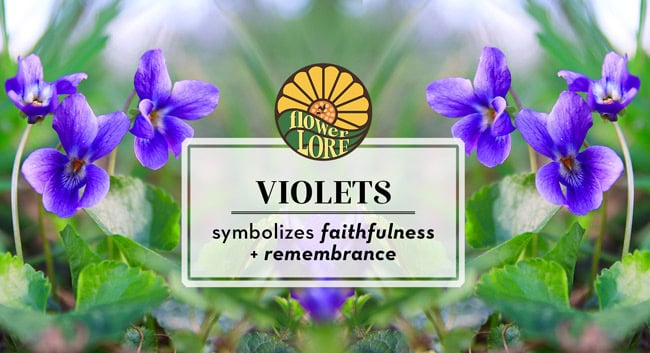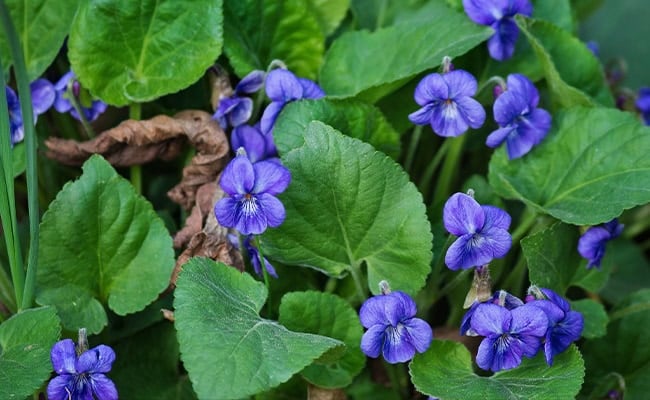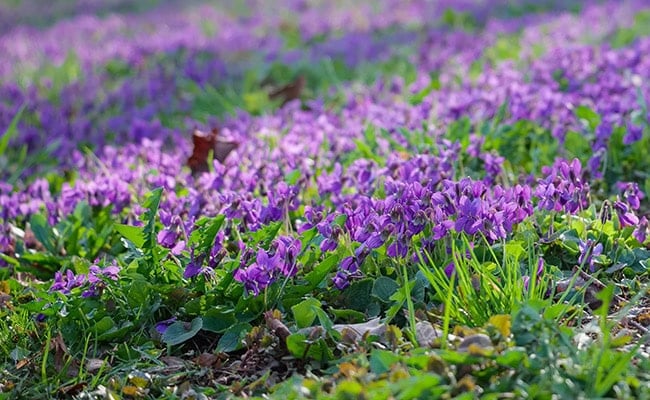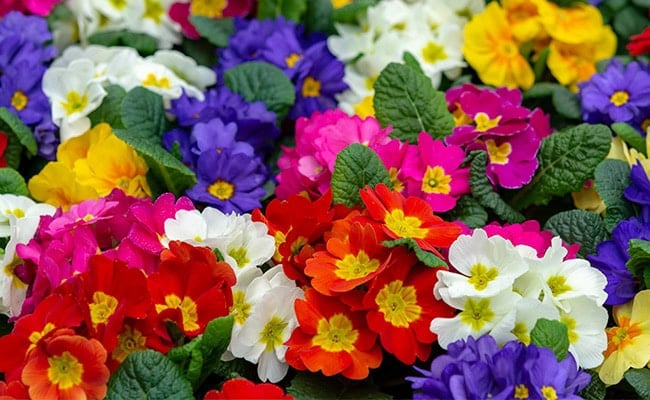Violet The February Birth Flower
Violets are edible, and are often used to decorate salads, or sprinkled over fish or poultry. They are also often candied in sugar and eaten on their own or used to decorate pastries, or distilled into a sweet syrup used to make violet-flavored treats or liqueurs.

Roses are red, violets are blue, we know which one is the February birth flower, do you? If you said violets, you’re right (roses are the June birth month flower). But why is the violet the birth flower of February, what do these blooms symbolize, and what violet flower facts and folklore tie these purple flowers to February? For instance, learn why violets are associated with St. Valentine! Explore the fascinating stories and meanings behind violets to discover their alluring mysteries! Jump to the story about violets and St. Valentine!
About Violets
The term “violets” refers to a wide range of related flowers. More than 650 species are part of the family Violaceae, genus Viola. Most are perennial blooms, though some are annuals or shrubs, especially when grown in different areas.
All violets have small lobed flowers, with leaves that may be heart- or kidney-shaped and may have scalloped edges. The sweet scent of most violets is very characteristic and endearing, making them favorites of many gardeners.

As expected, violets are typically purple, though shades can vary from lighter lilac hues to deep, rich midnight or blackish tones. Unlike typical purple flowers, the color “violet” generally is richer with blue undertones, though different violet flower cultivars are found with varying amounts of white, yellow, or brighter blue accents, with more modern blooms and hybrids even showing subtle maroon or a hint of pinkish shades. A blotch-like “face” is also characteristic of these flowers and is often accented with yellow or white.
The name violet comes from the French violete in the 1300s, as well as the Latin viola and Greek violeta. Because different types of violets are native worldwide in woodland areas, it is reasonable that there are many names for violets. In some areas, these flowers are called pansies, violas, and “heart’s ease,” while the quirkier name johnny-jump-ups refers to how quickly violets can grow early in the spring, seeming the “jump up” from the forest floor.
Because these flowers are some of the earliest spring bloomers, they are ideal to be symbolic as the February birth month flower, when the first signs of spring may begin to appear in warmer areas. While more northern areas won’t quite see violets in February, it is not unusual for these blooms to make their first appearances in the shortest month of the year.
Violet Symbolism
Violets are associated with a great deal of symbolism and folklore. The common blue violet, also called the confederate violet (Viola sororia) is the official state flower of four states–Illinois, Rhode Island, New Jersey, and Wisconsin, while the hooded blue violet–also known as the marsh blue violet or purple violet and also Viola sororia–is the official provincial flower of New Brunswick, Canada. Similarly, the common dog-violet (Viola riviniana) is the county flower of Lincolnshire, United Kingdom.
In Native American traditions, the Haudenosaunee people–part of the Iroquois Nation–believe violets to represent a child born of both earth and sky. This combination produces harmony and balance, with great opportunities that await.
Violets have also become associated with romantic relationships between women, and symbolize affection and friendship. Other symbolic associations for violets include chastity, modesty, loyalty, and humility. In Victorian floriography–the language of flowers – blue violets symbolize trust and devotion along with peace, calm, and tranquility, while white violets showcase innocence and purity.

Yet in some cases, violets represent sadness and grief. In ancient Rome, it was traditional to use violets for funerals to honor those who have passed, and in modern Thailand, violets continue to represent sorrow and mourning.
These flowers are occasionally associated with the Zodiac signs of Taurus (April 20 to May 20) and Capricorn (December 22 to January 19), and are also a symbolic flower of the fiftieth wedding anniversary, when they are traditionally paired with yellow roses. The yellow of the rose and the purple of the violets are complementary colors that represent the coming together of two individuals to complement one another.
Violet Flower Meaning Around The World
The vibrant color of violets also has its own symbolic associations, whether in the flowers themselves or just in hues reminiscent of the blooms. Purple tones have been associated with royalty in many ancient cultures, including the Roman, Persian, and Byzantine Empires, as well as European royalty. Even in the United States, shades of violet are meant for dignity and honor, such as in the Purple Heart awarded to distinguished military members for their bravery and service.
Purple has also become associated as one of the colors of Valentine’s Day – perfect for the February birth flower. This connection is likely due to the purple shade of amethyst, traditionally the February birthstone and a lovely purple hue similar to violet flowers. The luxurious gem is believed to encourage spiritual growth and increase one’s personal awareness, ideal associations for violets with their strong spiritual connections.
Violets themselves are also associated with St. Valentine, as one myth proclaims that the revered saint crushed violet flowers to create purple ink to write notes to friends while he was banished. Violets have also been noted as an ingredient in various love potions in ancient Greece, giving them yet another connection to the romantic holiday.
Related: Valentine’s Day Origins And Legends
By itself, the color purple also symbolizes creativity, ambition, wealth, and luxury, as well as magic and independence. The psychology of the color purple can be complex, especially as the color is relatively rare in nature – which makes violet flowers even more astonishing and special. Because of that rarity, purple also represents mystery, the supernatural, and even the divine–another connection to the violet’s Christian folklore.
Spiritual Symbolism of Violets
It is the humble nature and purity symbolism of violets that have led these flowers to be associated with the Virgin Mary in Christian folklore. When the Angel Gabriel told Mary that Jesus was to be her son and what he would mean to all men, violets blossomed to showcase her chastity and faithfulness. Medieval monks took the meaning of violets even further, calling them “flowers of Trinity” because of their spiritual symbolism and their trios of leaves.
Violets have also been part of ancient Greek mythology with connections to the goddess Artemis, who oversees the hunt, wildlife, and nature. Artemis is said to have changed one of her wood nymph consorts, who wished to always remain a chaste maiden, into a violet to protect her from the unwanted attentions of Apollo. Another Greek tale of violets notes that when Zeus turned Io into a heifer to hide her from the jealous wrath of Hera, Io’s tears of grief and sorrow became violets.
The Violet Flower in Art and Literature
The Christian folklore of violets and their connection to purity, innocence, and chastity has also been showcased in iconic pieces of art. In Leonardo da Vinci’s oil on canvas “Madonna and Child with Flowers” (Benois Madonna circa 1478-1480), a small sprig of violets is held by the Virgin and admired by the Child. Similarly, Giovanni Paolo’s “Madonna of Humility” (circa 1456) shows the Virgin seated amongst various wildflowers, violets included.
Noted English playwright and poet William Shakespeare (1564-1616) also used violets symbolically in several of his works. A sonnet published in 1584 contains the note of the violet flower meaning – “Violet is for faithfulness.” Shakespeare also references violets in several of his classic plays, including A Midsummer Night’s Dream, Hamlet, and Twelfth Night. In different instances in Shakespeare’s writings, the flowers are associated with sadness, sorrow, and grief.
Cooking With Violets
Like many different flowers, violets can be deliciously edible. The greens and blooms can both add a distinctive floral essence to salads or a be a mild seasoning for fish or poultry. Depending on the type of violet, flavors can even have hints of mild vanilla or wintergreen, ideal for hot teas. Colorful violets can be frozen in ice cubes as a beautiful accent for chilled drinks, perfect for spring lemonades or summertime teas.
Violet flowers can be candied, sugared, or crystalized, and they make lovely and unique decorations for cookies, cupcakes, or cakes. They can also be used to create syrups for flavoring, or made into jams and jellies.
Violets have many health benefits. Depending on the exact variety, violet flowers are rich in antioxidants as well as vitamins A, B, and C. They have anti-inflammatory properties and can be used for arthritis or other joint ailments, and are said to help relieve headaches. Violet-based syrups can be useful for cough suppression as well.
If you plan to cook with violets, it is best to grow the blooms yourself. In doing so, you can be certain of how the plants are treated with respect to pesticides, herbicides, and other chemicals, and you can also ensure the violets you use are as fresh and healthy as possible to maximize their flavor and health benefits.
Growing Violet Plants
Different types of violets have been cultivated for more than 500 years, and today these beautiful blooms are grown in flowerbeds, containers, and window boxes worldwide. They do well as colorful borders, and smaller varieties can even serve as unique groundcovers.
While many violets are naturally perennials and can thrive in gardening hardiness zones 2-11 depending on the exact variety, they are often treated as annuals and replaced from year to year. Violets can grow from 3-12 inches tall and will spread from 4-10 inches wide, so space the plants accordingly to provide them adequate room. If overcrowded and without proper airflow, violets can be susceptible to mold. Thinning violets can also ensure good airflow to keep the plants healthier.
These flowers do best in part shade to full sunlight, though in warmer regions afternoon shade is best to avoid burning the plants. Partial or dappled shade also better mimics the woodland conditions where violets thrive naturally.
Rich, organic soil is best for violets and more closely approximates the natural forest floor where these plants naturally sprout. Amending soil with compost or a good quality, slow-release fertilizer will help nourish violets to reach their full growth and most colorful blooms. They will also need consistent watering but should not be left soggy, which could easily lead to rot. Mulching violets can help keep moisture available without accidentally overwatering or risking the roots drying out.
Violets can be planted as seeds or seedlings. In northern areas with shorter growing seasons, seedlings may be a better choice, but if they are started inside, they will need to be properly hardened off to adapt to outdoor conditions when transplanted.
These gorgeous flowers will provide a brilliant show of blooms from spring through fall. Deadheading violets throughout the season will extend bloom time and ensure the maximum color from each plant for full enjoyment of their beauty.
A Note About African Violets
In considering violets, it is important to note that the popular African violet is not a true violet. Instead, African violets are herbaceous perennials native to Tanzania, southeast Kenya, and other parts of eastern Africa. They belong to the genus Streptocarpus, and come in a wider range of purple, white, blue, and pink blooms. While beautiful flowers, they are not violets in the same sense as February’s birth flower, but they can still be a lovely gift for anyone who loves violets but may not be able to properly plant or care for true violets.
Another February Birth Flower – The Primrose
Violets are not the only flowers associated with February. While they are the primary February birth month flower, the primrose is actually a secondary birth flower for the month. These early spring perennials come in a rainbow of different hues, from pink, red, and white to yellow, orange, purple, and blue. Some varieties even offer multi-colored blooms with contrasting borders or variegated petals for a very distinctive look.

Like violets, primroses have a great deal of symbolism, including associations with youth, renewal, and young love due to their early spring appearances.
In Norse mythology, the primrose is associated with Freya, the goddess of love, while in Celtic legends, primroses are connected to fairies and are able to drive away evil spirits. Also similar to violets, primroses have had various medicinal uses throughout history, including to treat headaches and joint ailments. They are also edible and often made into teas or even fermented into wine.
With so much history, culture, and symbolism associated with violets, it is no surprise that they are a popular bloom not only as the February birth month flower, but all year round with their stunning colors, sweet scents, and overall beauty.
Join The Discussion
Which flower do you prefer: violets or primrose?
Did anything surprise you about the violet flower meaning?
Share your tips and tricks for the most beautiful violets and primroses in the comments below!
Related
How To Grow A Birth Flower Garden
Related product: February Birthstone – Amethyst Necklace

Melissa Mayntz
Melissa Mayntz is a writer who specializes in birds and birding, though her work spans a wide range—from folklore to healthy living. Her first book, Migration: Exploring the Remarkable Journeys of Birds was published in 2020. Mayntz also writes for National Wildlife Magazine and The Spruce. Find her at MelissaMayntz.com.






Awesome!
Thank you great article.